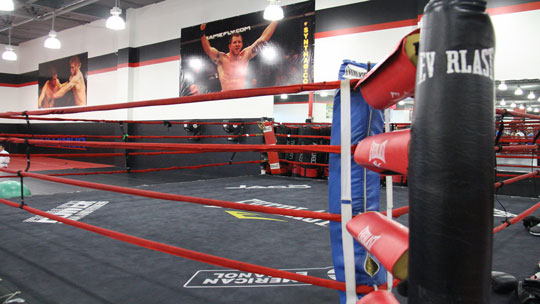
MMA pits two fighters against each other in the ultimate contact sport. (Photo by Meghan Kuebler)
At first glance, mixed martial arts and cheerleading appear to be at the opposite ends of the safety spectrum. But they share similar concerns and protocols when it comes to concussions.
Bottom line: Beware. At the youth level, both can be hazardous to your health.
Ankle injuries, hand injuries and muscle injuries are common in cheerleading, said Jennifer Lannon, owner of the Arizona All-Stars cheerleading program. But so are concussions.
“If something does happen and they do get a concussion or they do have a head injury, we don’t move them,” Lannon said. “Typically, what our protocol is we assess the situation and then from there, we will call 911 if needed.”
With situations involving stunt maneuvers and potentially dangerous outcomes only a slight mistake away, cheerleading, like other sports, is prone to head collisions.
At a competition in Palm Springs, California, 15-year-old cheerleader Madison Woolgar warmed up with her team outside the hotel in a grassy area.
“We do a stunt where we throw the flier and she stands on another girl and then comes down toward us,” Woolgar said. “It went crooked and she landed on my head, her elbow and knee went into my head and then I passed out and it went from there.”
Karlee Brown, 12, says she suffered a concussion but only sat out a day before returning to practice for a weekend competition.
“I tried practicing on Friday, I had a headache, and then I was just kind of a little dizzy at the end but I just had to push through it.”
Accidents like this are common in cheerleading. Lannon recalls a recent injury occurring in practice involving a young girl who hit her head.
“She was on the bottom of a pyramid and the pyramid came down,” Lannon said. “The knee went into her head and she was fine when she got down and then she progressively got worse.”
Lannon then called 911.
Then there’s mixed martial arts, a sport in which contact is the name of the game.
“Smiling” Sam Alvey is a professional fighter competing in the Ultimate Fighting Championship promotion. He is also the head MMA instructor for children at Dan Henderson’s Athletic Fitness Center in Temecula, California.
According to the United States Fight League, head strikes are prohibited for fighters under the age of 16.
“They (the parents) don’t want their kids getting punched,” Alvey said. “I say, ‘That’s not what we’re teaching them. Maybe in 10 years we can start working on some headshots, but right now they’re just kids.’ I’m not a neurosurgeon, but I know getting hit in the head is bad for you, especially at such a young age.”
Still, incidental head contact occurs.
“I tell the kid who made the contact why it was wrong and what happened,” Alvey said. “Nobody is doing it on purpose, but accidents do happen.”
It wasn’t always like this. Before concussions and head trauma came under the microscope, practices at many levels of MMA, especially at the professional level, featured hard, often grueling sparring. Now, training is focused on sparring correctly rather than brutally.
“You don’t need to take sparring out,” said Chael Sonnen, ESPN analyst and former UFC fighter. “You just need to be a good partner and then you have to work out with a guy who is a good partner.”
Former UFC fighter Aaron Simpson, one of the owners of Power MMA and Fitness in Gilbert, said technique is getting better.
“We don’t just send a guy in and spar five times a week and they get a brain injury the next day and come back to training and spar again,” Simpson. “I mean, if you get knocked out you’re out for a while. It takes a long time and we understand this now, it takes a long time for your brain to heal.”
In a sport where one of the main objectives at the professional level is to knock your opponent out, it would be nearly impossible to eliminate concussions altogether.
Dr. Ken Ota, a ringside physician with the Arizona Boxing and MMA Commission, believes the sport should discuss how to avoid concussions in MMA. But there’s a more realistic approach.
“At this point that would be to figure out how is it that we screen fighters initially trying to obtain data,” Ota said. “Telling us what their baseline cognitive status, neurological status, neuropsychological status is so that we can measure it over time to determine a threshold at which we should probably be advising them, ‘Look it may be time to retire from the sport.'”
Regardless of the sport, there’s an inherent risk for injury – and it’s not just limited to cheerleading or MMA.
“I don’t understand why a person would want to jump out of an airplane,” Sonnen said. “I can’t wrap my head around that, but I damn sure want them to have that choice.”